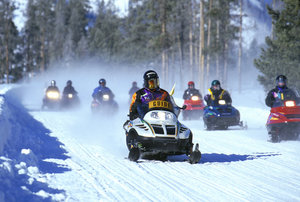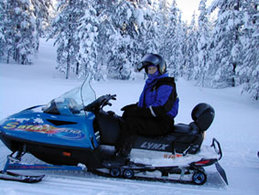Snowmobile

A snowmobile (or snow scooter, often referred to by enthusiasts as a 'sled' and in the Canadian north as a 'snow machine') is a land vehicle propelled by one or two rubber tracks, with skis for steering. They are designed to be operated on snow and ice, and require no road or trail. Most snowmobiles are powered by two-stroke gasoline/petrol internal combustion engines. Even though they are not designed for it, snowmobiles will skim on top of water if the speed is high enough, as demonstrated by the annual snowmobile river drag race in Kautokeino, Norway.
The earliest snowmobiles were modified Ford Model Ts with the undercarriage replaced with tracks and skis. They were popular for rural mail delivery for a time. Polaris Industries in Roseau, Minnesota, in the United States Midwest, was a pioneer in the production of purpose-built snowmobiles.
The relatively dry snow conditions of the United States Midwest made the converted model Ts and other like vehicles not suitable for operation in more humid snow areas such as Southern Quebec. This led Joseph-Armand Bombardier of the small town of Valcourt in Quebec, Canada, to invent a different caterpillar track system suitable for all kinds of snow conditions. (The Kegresse track, a similar rubber track, was used on off-road halftrack military trucks before and during World War Two. It was developed by France and used in a variety of combat vehicles by the U.S. [1]) He started production of a large, enclosed, seven-passenger snowmobile in 1937, and introduced another enclosed twelve-passenger model in 1942.
It was only in 1959 that he invented what we know as the modern snowmobile in its open-cockpit one- or two-person form, and started selling it as the "Ski-doo". Competitors sprang up and copied and improved his design. In the 1970s there were hundreds of snowmobile manufacturers. From 1970 to 1973 they sold close to two million machines, a sales summit never since equalled. Many of the snowmobile companies were small outfits and the biggest manufacturers were often attempts by motorcycle makers and outboard motor makers to branch off in a new market. Most of these companies went bankrupt during the gasoline crisis of 1973 and succeeding recessions, or were bought up by the larger ones. Sales reached a peak of 260,000 in 1997 and went down gradually, influenced by warmer winters and the use during all four seasons of small one- or two-person ATVs. Bombardier Recreational Products, a former division of the first company, still makes snowmobiles, outboard motors, personal watercraft, and ATVs. The snowmobile market is now divided up between four big makers: Bombardier, Arctic Cat (Artco), Yamaha, and Polaris.

Snowmobiles are widely used in arctic territories for travel. However, the small population of the Arctic areas makes for a correspondingly small market. Most of the annual snowmobile production is sold for recreative purposes much further south, in those parts of North America where the snow cover is stable during the winter months. The number of snowmobiles in Europe and other parts of the world is relatively low.
Modern snowmobiles can achieve speeds in excess of 193 km/h (120mph). (Racing snowmobiles reach speeds in excess of 241 km/h [150mph]). People die every year when they crash into other snowmobiles, automobiles, pedestrians, or trees or fall through ice. Around 10 people a year die in such crashes in Minnesota alone with alcohol a contributing factor in many (but not all) cases. In Saskatchewan, 16 out of 21 deaths in snowmobile collisions between 1996 and 2000 were alcohol-related[2].
Industrial-type snowmobiles for grooming cross-country ski trails and right of way maintenance are also made. They are large enclosed vehicles which can carry passengers and cargo, and tow sleds. Unlike the recreational snowmobile they are completely tracked and have no skis in the front. They are powered by strong 4- ,6- or 8-cylinder diesel or petrol engines.
Environmental impact
The environmental impact of snowmobiles has been the subject of much debate. Most snowmobiles are still powered by two-stroke engines, which generate disportionate amounts of air pollution and noise. In the last decade several manufacturers have been experimenting with less polluting motors, and putting most of them in production. Yamaha and Arctic-Cat were the first to mass produce four-stroke models, which are significantly less polluting than the early two-stroke machines. Bombardier and Polaris followed.
On November 4, 2004, the National Park Service of the United States approved a Finding of No Significant Impact (FONSI) for the Temporary Winter Use Plans and Environmental Assessment for Winter Use in Yellowstone and Grand Teton National Parks and the John D. Rockefeller, Jr., Memorial Parkway. The Final Rule implementing this decision was published in the Federal Register on November 10, 2004.
This decision allows 720 snowmobiles per day in Yellowstone, all commercially guided. In Grand Teton National Park and the John D. Rockefeller, Jr., Memorial Parkway, 140 snowmobiles would be allowed. With minor exceptions, all snowmobiles would be required to meet NPS Best Available Technology (BAT) requirements. The plan will be in effect for three winters, allowing snowmobile and snowcoach use through the winter of 2006-2007.
